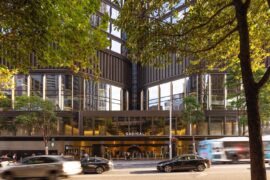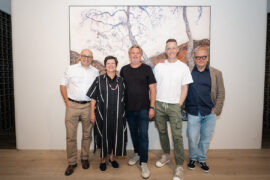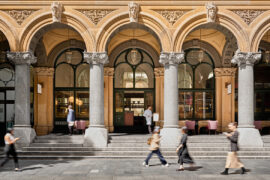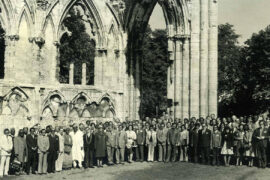An exhibition uncovers the design history of Melbourne’s Shrine of Remembrance, marking the building’s 90th anniversary.

Photograph by Earl Carter.
August 22nd, 2024
Designing Remembrance: Alternative visions for Victoria’s war memorial is currently on show at Melbourne’s Shrine of Remembrance. The exhibition opened on 13th August, exactly 90 days before the Shrine’s 90th anniversary, and displays an array of alternative architectural designs.
Co-curated by Dr Katti Williams, Neil Sharkey and Dr Laura Carroll, the new exhibition features detailed plans, conceptual drawings and correspondence, and conversations between designers and builders from the 1920s. The grandchildren of the Shrine’s designers, Philip Hudson and James Wardrop, were also involved. The exhibition showcases the original shortlist of alternative proposals from the 1923 competition to design the war memorial and allow visitors to reflect on Victoria’s history of remembrance. Indeed, it’s the first time that the alternative designs have been exhibited in 80 years, following the rediscovery of the blueprints that were lost to a fire in 1925.

This type of ‘counter-factual’ exhibition is perhaps one of the most intriguing, engaging and valuable forms of architectural curation. It’s able to provide greater understanding of the actually built design, as well as the design process in general as visitors’ imaginations are fired by seeing what might have been. Alongside a deeper appreciation of the architect’s labour and rationale, the exhibition also encourages critical thinking about architecture and design as people weigh up their preferences, what worked and what didn’t.
Professor Philip Goad is an architectural historian at the University of Melbourne who consulted on the exhibition. He comments on the importance of this kind of counter-factual display of unbuilt design: “I think looking at the so-called ‘Salon des Refusés’ is a really wonderful way to see what might have been. In many major competitions, some of the entries that didn’t win become extraordinarily influential.”
Related: Reviving a modernist gem at the University of Sydney

Goad continues: “I think competitions can actually influence the trajectory of where design moves – but you actually have to have a public showing of the entries for there to be an effect. [It can have] significant influence in steering architecture culture – they become just as important as the built object.”
Co-curator Neil Sharkey explains how the idea of focusing on the design competition as part of the 90th anniversary came about: “We all know what the Shrine of Remembrance is, but we were interested in the whole process of how the set of commemorative values that the Shrine represents came to be the language of commemoration in the state. It’s really about capturing people’s attention – and their imagination.”

Sharkey expands on the point about imagination, emphasising how an exhibition such as this one opens up space to really think differently about design. “The Shrine [is] so big, imposing, solid and permanent in its appearance alone that it’s probably difficult for someone who sees it to imagine there could have been something else there,” he says. “It’s very usual to remind people that the building didn’t materialise from nowhere – it was part of a very involved process and it was up against some very stiff competition by some very talented architects.”
Imagination, appreciation and understanding, then, seem to be the core offerings of Designing Remembrance. To curate something from the past, however, is not simply to re-tell an old story; it also creates the possibility of new ones. “The great thing about history is that it’s a story,” says Goad. “The wonderful thing is going into archives [to] select very carefully, and then you can put a new story together from the collection of the past. That’s something that’s exciting – the archive still has a life and a relevance.”

Goad also draws attention to the need to congratulate the Shrine for taking this direction with the exhibition. It shows a certain self-assurance for any architecture to put on show what might have been, while the architectural focus of the exhibition opens up new dimensions of experience for visitors over and above the usual emphasis on war.
“I think they got it right for Melbourne at the time,” says Goad, commenting on the architecture of the actually built Shrine of Remembrance. As Designing Remembrance invites us to, in some sense, indulge in a remembrance of remembrance, it’s a rare opportunity critically engage with and be inspired by some unbuilt design work. As Mark Fisher wrote, “we must reveal what is presented as necessary and inevitable to be a mere contingency, just as it must make what was previously deemed to be impossible seem attainable.” The architectural counter-factual allow us to speculate on the past in order to draw out the perpetual openness and possibility of future design.
Designing Remembrance
shrine.org.au


INDESIGN is on instagram
Follow @indesignlive
A searchable and comprehensive guide for specifying leading products and their suppliers
Keep up to date with the latest and greatest from our industry BFF's!

London-based design duo Raw Edges have joined forces with Established & Sons and Tongue & Groove to introduce Wall to Wall – a hand-stained, “living collection” that transforms parquet flooring into a canvas of colour, pattern, and possibility.

Rising above the new Sydney Metro Gadigal Station on Pitt Street, Investa’s Parkline Place is redefining the office property aesthetic.

Eco Outdoor recently brought together developers, sustainability experts and local architects such as Adam Haddow to discuss design fundamentals, carbon targets and long-term thinking.

The Parliamentary Friends reconvened at Parliament House, uniting political and professional leaders to champion architecture and design.
The internet never sleeps! Here's the stuff you might have missed

Luchetti Krelle’s timeless design at Epula marries heritage grandeur with classic sophistication, celebrating the spirit of a European piazza whilst remaining unmistakably of its place.

Celebrating six decades of architectural excellence, the Commonwealth Association of Architects launches a year-long campaign.